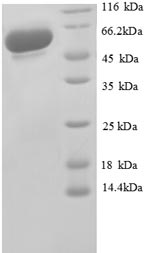Enhance your apoptosis research with our high-quality Recombinant Human GAPDH protein. Glyceraldehyde-3-phosphate dehydrogenase (GAPDH) is a well-known enzyme involved in glycolysis and gluconeogenesis, playing a crucial role in cellular energy production. Beyond its metabolic functions, GAPDH has emerged as a key player in apoptosis, making it a valuable target for the study of cell death and survival mechanisms.
Our Recombinant Human GAPDH protein is expressed in E.coli, resulting in a partial-length protein that encompasses the 3-335aa region. The N-terminal GST-tag enables efficient purification and detection for seamless integration into your experiments. With a purity greater than 90% as determined by SDS-PAGE, our Recombinant Human GAPDH protein provides the reliability and consistency you need for your research endeavors. Choose from liquid or lyophilized powder forms to accommodate your laboratory's requirements, and trust our Recombinant Human GAPDH protein to drive your apoptosis research forward.






